![]()
![]()
![]()
Use LEFT and RIGHT arrow keys to navigate between flashcards;
Use UP and DOWN arrow keys to flip the card;
H to show hint;
A reads text to speech;
99 Cards in this Set
- Front
- Back
|
Who needs a circulatory system?
|
Most multicellular organism
|
|
|
Why is a circulatory system needed by multicellular animals?
|
- diffusion or active transport is unsually not adequate for cell respiration
|
|
|
What determines for an effective circulatory system?
|
- body size
- shape - activity levels |
|
|
role of circulatory fluids
|
Transport of:
- nutrients - water - wastes - gases - other: - house/transport white blood cells (protects against disease) - transport hormones |
|
|
Two types of circulatory systems
|
- Open circulatory system
- closed circulatory system |
|
|
3 basic Components of a circulatory system
|
- A circulatory fluid (blood/hemolymph)
- a set of tubes (blood vessels) - a muscular pump ( the HEART) |
|
|
Insects, other anthropods, and most molluscs blood bathes the organ directly in an
|
open circulatory system
|
|
|
In an open circulatory system, there is no distinction between blood and interstitial fluid. This fluid is called
|
- Haemolymph
|
|
|
Blood is always contained in
|
Vessels
|
|
|
Blood is confined to vessels and is distinct from the interstitial fluid in a
|
Closed Circulatory System
|
|
|
Closed systems are more _______ at transporting circulatory fluids to tissue and cells.
|
Efficient
|
|
|
Open circulatory system vs Closed Circulatory system (picture)
|
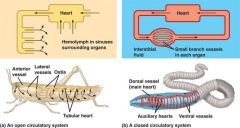
|
|
|
other name for a closed circulatory system for humans and other vertebrates
|
Cardiovascular System
|
|
|
The three main type of blood vessels are:
|
- arteries
- veins - capillaries |
|
|
Arteries
|
- carry blood away from the heart
- heart > arteries > arterioles > capillaries >capillary beds |
|
|
Network of capillaries are called?
|
Capillary beds
|
|
|
Capillary beds are the sites of
|
- chemical exchange between the blood and interstitial fluid
|
|
|
Veins
|
- return blood from the capillaries to the heart
- capillary bed > Venules > Veins > Heart |
|
|
Bony fishes, rays, sharks have a ____1___ circulation circulatory system with a____2____ heart.
|
1- single
2- two- chambered |
|
|
In single circulation, blood leaving the heart passes through two _______________ before returning
|
- capillary beds
|
|
|
Blood that is oxyginated by the gills
|
- never returns to the heart to be pumped to the bodies
- goes directly to body tissues before returning to the heart |
|
|
Fish circulatory system (picture)
|
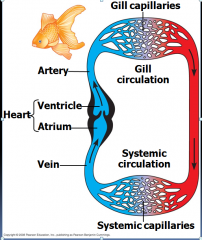
|
|
|
Amphibians, reptiles, and mammals have a
|
- double circulation Circulatory system
|
|
|
Oxygen-poor and oxygen-rich blood are pumped
|
- separately from the right and left sides of the heart
|
|
|
Left side of the heart has
|
Oxyginated blood
|
|
|
Right side of the heart has
|
- de-oxyginated blood
|
|
|
In reptiles and mammals, oxygen poor blood flows through the
|
- Pulmonary circuit
- to pick up oxygen through the lungs |
|
|
In amphibians, oxygen-poor blood flows through a
|
- Pulmocutaneous circuit
- to pick up oxygen through the lungs and skin |
|
|
Systemic Circuit
|
- where oxygen rich blood is delivered
|
|
|
Double circulation maintains a
|
- a higher blood pressure compared to single circulation
|
|
|
Amphibian Circulatory
Frogs and other amphibians have a |
- three chambered heart
- with two atria and one ventricle |
|
|
Amphibian circulatory
|
- the ventricle pumps blood into a forked artery that splits the ventricle's output into the pulmocutaneous circuit and systemic circuit
- Underwater, the flow to the lungs is nearly shut off |
|
|
Reptiles circulatory (except birds)
Turtles, snakes, and lizzard have a |
- three-chambered heart
- with Two Atria and One Ventricle |
|
|
Reptiles Circulatory
In alligators, caimans, and other crocodilians |
- a SEPTUM divides the ventricle
- They have a double circulation - with a pulmonary circuit - and a systemic circuit |
|
|
Mammals and Birds Circulatory
Mammals and Birds have a |
- Four-chambered heart
- with Two Atria and Two Ventricle |
|
|
Mammals and Birds Circulatory
The left side and the right side of the heart pumps... |
- the left side of the heart pumps and recieve ONLY oxygen-rich blood
- right side receives and pumps ONLY oxygen-poor blood |
|
|
Mammals and Birds are ________ and require more O2 than ectotherms
|
- endotherms
|
|
|
Fish, amphibian, reptile. mammal circulatory (picture)
|
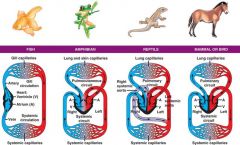
|
|
|
Mammalian Circulation part 1
|
- Blood begins flow with the RIGHT VENTRICLE pumping blood to the lungs
- In the lungs, the blood loads O2 and unloads CO2 - Oxygen rich blood from the lungs enters the heart at the LEFT ATRIUM and is pumped through the AORTA to the body tissues by the left Ventricle |
|
|
The Aorta provides blood to the heart through the
|
- Coronary Arteries
|
|
|
Mammalian Circulation part 2
|
- Blood returns to the heart through the Superiour Vena Cava ( blood from the head, neck, and forelimbs) and Inferior Vena Cava ( blood from trunk and hind limbs)
- The superior and inferior vena cava flow into the RIght Atrium |
|
|
Blood circulation in mammals (human)
|
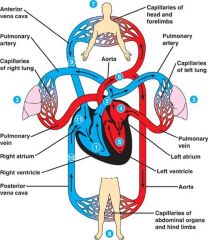
|
|
|
Vertebrate hearts contain
|
- two or more chambers
|
|
|
Blood enters through an __1___ and is pumped out through a ____2___
|
1- atrium
2- ventricle |
|
|
Cardiac Cycle
|
- a rythmic cycle, contraction and relaxation of the heart
|
|
|
The contraction, or pumping phase is called
|
Systole ( Sis-to-lee)
|
|
|
The relaxation or filling phase is called
|
- Diastole (Dai-as-to-lee)
|
|
|
Four valves prevent backflow of blood in the heart
|
- The Atrioventricular (AV) valves (separate each ventricle and atrium)
- The Semilunar Valves which controls blood flow to the aorta and the pulmonary trunk |
|
|
Heart Picture
|
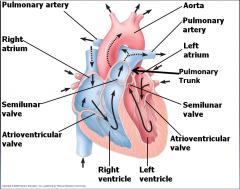
|
|
|
Composition of blood
|
- Plasma
- Cells - Platelets |
|
|
Plasma
|
- Aqueous portion of blood containing dissolved substances and cells and platelets
|
|
|
Cells
|
- Red blood cells, carry gases
- white blood cells, protect against disease |
|
|
Platelets
|
- Cell fragments involved in blood clotting
|
|
|
Blood Plasma
|
- Over 90% water
- 7% plasma proteins -created in liver - confined to blood stream - 2% other substances: electrolytes, nutrients, hormones, gases, waste products |
|
|
Plasma proteins
|
- Albumin: maintain blood osmotic pressure
- Globulins (immunoglobulins) -Antibodies bind to foreign substances called anitgens - form antigen-antibody complexes - Fibrinogen: for clotting |
|
|
On average, humans have about
|
- 6 liters of blood
- circulated completely once every 20 seconds |
|
|
Blood functions to
|
- transport nutrients, gases and regulatory molecules (hormones) and waste material
- Regulate pH and control osmosis - Regulate body temperature - Defend the body against infection and other foreign substances - regulate the clotting process |
|
|
Lymph
|
- fluid that has "leaked" from blood capillaries and has then moved into lymph vessels
|
|
|
Lymph is similar in composition to blood except that it
|
- lacks red blood cells and platelets
|
|
|
Function of the lymph system
|
- Returns tissue fluid to the circulatory system
- carries some wastes to the circulatory system - carries some absorbed nutrients from the digestive tract to the circulatory system |
|
|
Respiratory in animals
Respiratory Media |
- animals can use air or water as a source of O2
- in a given volume, there is less O2 in water than in air - Obtaining water from water requires greater efficiency than air breathing |
|
|
Any mechanism that maximizes gas exchange between an organism and its environment is called
|
- Ventilation
- Ventilation: moves the respiratory medium over the respiratory surface |
|
|
Gas exchange (respiratory exchange)
|
- supplies oxygen for cellular respiration and disposes of carbon dioxide
|
|
|
Cellular Respiration
|
- occurs at the cellular level and is responsible for the production of ATP
|
|
|
Respiratory in Animals requirements
|
- Large, moist respiratory surface required for respiratory exchange
|
|
|
Respiration in Unicellular organisms
|
- Simple Diffusion across cell membrane
|
|
|
Respiration in Large organisms
|
- Exchange Across Body Wall
|
|
|
Respiratory Surfaces
Animals require a |
- large, moist respiratory surfaces for exchange of gases between their cells and the respiratory medium, either air or water
|
|
|
Gas exchange across respiratory surfaces (skin) takes place by
|
- Diffusion
|
|
|
Respiratory surfaces vary by animal and can include
|
- the outer surface
- skin - gills - tracheae - lungs |
|
|
Respiratory in Animals
- planarians |
- increased surface area to body volume ratio
|
|
|
External gills
|
- finely divided giving rise to large surface area
- rest of body surface may also participate in respiratory exchange - found in some polycheate worms and amphibians - (Nectoris, Mud puppies) |
|
|
Internal gills (protected)
|
- present in most body fish
- countercurrent exhange (later slide) |
|
|
Insects
|
- tracheal system of respiratory exchange, gases moved directly to cells
|
|
|
Air-breathing vertebrates
|
- lungs, internal system, gas transported to all tissues through cardiovascular system
|
|
|
Counter current exchange
|
- This mechanism affects ventilation in fish
- blood flows in ONE DIRECTION over the gills while water passes in the OPPOSITE DIRECTION - Diffusion gradient favours O2 transfer throughout the length of the gills |
|
|
Ventilation in fish (pic)
|

|
|
|
Internal lungs
|
- found in air breathing vertebrates
- Lungs are infolding of the body surface - The circulatory system (open or closed) transport gases between the lungs and the rest of the body |
|
|
Lungs in humans (pic)
|
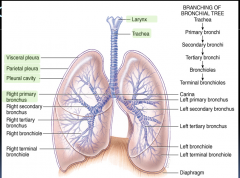
|
|
|
Respiration in Amphibians
|
- Do not have a diaphram
- moist skin of frog is also used in respiratory exchange (specially under water when lungs are shut off) - air is later forced out through the Buccal cavity |
|
|
Ventilation in Anarchnids (spiders etc...)
|
- Spiders have a body structure consisting of a CEPHALOTHORAX and ABDOMEN
- Respiratory exchange organs are a TRACHEAand BOOK LUNGS - trachea extends into interior tissues and supplies most body cells directly (no circulatory fluid required) - Book lungs are in the anterior abdomen. Moist air passes across them and gases diffuse into body cavity and circulate in open circulation |
|
|
Spider pic
|

|
|
|
Ventilation in insects
|
- Tracheal system
- Spiracles - openings of trachea - Trachea are lined with chitin which is impermeable to gases - Gases must pass through Terminal Tracheols to get to cells |
|
|
Insect respiratory pic
|
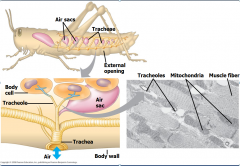
|
|
|
Ventilation in Amphibians
|
- Frogs use Positive Pressure breathing to ventilate their lungs
- Air is drawn into buccal cavity through nose with mouth closed - Buccal cavity is enlarged through lowering of its floor - Nasal Valve then closes and buccal floor raised - Positive pressure forces air into lungs |
|
|
Ventilation in Birds
|
- in addition to lungs, birds have eight or nine air sacks
- Air sacks are located in abdomen, neck and wings - Air sacks act as Bellows - Air passes through the lungs in ONE DIRECTION ONLY, during inspiration and expiration - Every exhalation completely renews the air in the lungs - This enables efficient gas exchange for flight |
|
|
Bird respiration Pic
|
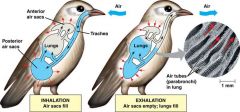
|
|
|
How a Mammal Breathes
|
- Mammals ventilate their lungs by negative pressure breathing, which pulls air into the lungs
- Lung volume increases as the rib muscles and diaphragm contracts |
|
|
Quiet Inspiration
|
- Diaphragm moves 1 cm and ribs lifted by muscles
- Intrathoracic pressure falls and 2-3 liters inhaled |
|
|
Quiet Expiration
|
- Passive process with no muscle action
- Elastic recoil and surface tension in alveoli pulls inward - Alveolar pressure increases and air is pushed out |
|
|
Respiration in humas pic
|
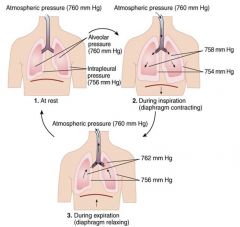
|
|
|
Respiration in humans (simplified)
|
- inhilation- diaphram contracts (moves down), rib cage expands as rib muscle contract , air inhaled
- Exhalation - Diaphram relaxes, Rib cave gets smaller as rib muscle relax, air exhaled |
|
|
Partial Pressure Gradient in Gas exchange
|
- gases diffuse down pressure gradients in lungs and other organs as a result of differences in partial pressure
- Partial Pressure is the pressure exerted by a gas in a mixture of gases |
|
|
A gas diffuses from a region of
|
- Higher partial pressure
- to a region of Lower partial pressure - in the lungs and tissues, O2 and CO2 diffuse where their partial pressures are higher to where they are lower |
|
|
Coordination of circulation and gas exchange
|
- Blood arriving to the lungs have a low partial pressure of O2 and high partial pressure of CO2 relative to air in alveoli
- In the alveoli, O2 diffuses into the blood and CO2 diffuses into the air - In tissue capillaries, partial pressure gradients favor diffusion of O2 into the interstitial fluids and CO2 into the blood |
|
|
Partial pressure of gasses diffusion PIC
|
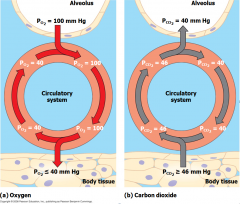
|
|
|
Oxygen transport
red blood cells |
- Red blood cells ( erythrocytes) are by far the most numerous blood cells
- they transport oxygen throughout the body - they contain Haemoglobin, the iron containing protein that transport oxygen - 98.5% of oxygen attached to the Haeme of haemoglobin - Haemocyanin does a similar job in anthropods and some molluscs |
|
|
Carbon Dioxide transport
|
- 70% transported as bicarbonate ions (HCO3)
- 23% attached to the GLOBIN of haemoglobin - 7% dissolved in plasma |
|
|
Diving animals
(very efficient respiration and circulation) |
- can store large amounts of O2 to remain underwater longer
- have high amounts of Myglobin (found only in muscle cells) that stores O2 - use minimal muscle movement to move - Hear rate decrease before a dive ( some may have 1 beat per minute) - blood only goes to essential tissues |

